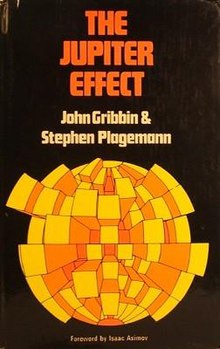The Jupiter Effect

Cover of the first edition
|
|
| Author | John Gribbin |
|---|---|
| Language | English |
| Subject | Astronomy |
|
Publication date
|
1974 |
| Media type | Print (Hardcover and Paperback) |
| Pages | 136 |
| ISBN | |
The Jupiter Effect is a 1974 book by John Gribbin and Stephen Plagemann, in which Gribbin and Plagemann predicted that an alignment of the planets of the Solar System would create a number of catastrophes, including a great earthquake on the San Andreas Fault, on March 10, 1982. The book became a best-seller. The predicted catastrophes did not occur.
Astronomers had long been aware that there would be an alignment of the planets on that date, when Mercury, Venus, Earth, Mars, Jupiter, Saturn, Uranus, Neptune and Pluto would be on the same side of the Sun, within an arc 95 degrees wide. But no effect could be expected as the gravitational effect of the other planets on the Earth's crust is minimal even at their closest approach. In this book, the authors sought to partially sidestep these objections by considering the effect of the alignment on the Sun, and hence on the solar wind, which in turn is known to affect weather on the Earth. Atmospheric conditions on the Earth can alter the speed of its rotation. The effect on the Sun would also be quite small, however, and in fact there had been an even closer alignment in the year 1128 without any incident.
There was some influence by the planets mentioned above, with the high tides calculated as being about 40 micrometres higher than normal. In April 1982, Gribbin and Plagemann published a lesser-selling book, The Jupiter Effect Reconsidered. In it they theorized that the effect had actually taken place in 1980, despite the lack of planetary alignment then, and that it had triggered the volcanic eruption of Mount St. Helens.
...
Wikipedia
